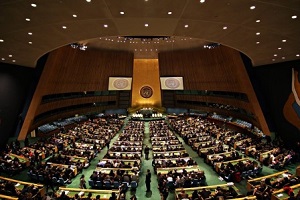Adelyne More’s 1917 feminist pamphlet Fecundity and Civilization stated flatly that population stabilization “is the most effective way of ensuring the cessation of war.”[1] All species’ potential rates of reproduction enable exponential population growth. Population numbers are kept within environmental capacity by rising mortality as populations increase. Ecologists call this process “density-dependent mortality.” Many “group-selected” social species fight territorial wars as populations grow, such as chimpanzees, lions, wolves, hyenas, baboons, ants, and humans.

Population density is a huge factor for fights among chimpanzees. The threat of losing territory and resources creates tension and physical confrontation until there is a standing winner. Sound familiar? (Image CC BY-SA 2.0, Credit: Chris Allen)
|
Writer Michael Balter concluded from a study of 100 incidents (in which chimpanzees inflicted deaths on rival bands) that population growth leads to violent conflict. Studies of hunter-gatherer cultures, as well as historical records of modern societies, show that wars, famine, and disease reduce life expectancy as populations push environmental limits.
Humans and many other species also “regulate” population, not necessarily intentionally, within environmental capacity through behaviors that reduce birth rates (“density-dependent natality”).
Scholars present multifaceted causes of violence and war. In Causes of War, Levy and Thompson describe how “Scholars disagree not only on the specific causes of war, but also on how to approach the study of war…psychologists generally emphasize psychological factors, economists emphasize economic factors, anthropologists emphasize cultural factors, and so on.”[2] Philosopher A.C. Grayling quotes I.A. Novikov on the purpose of war: “men fought…in order to obtain food, women, wealth, the profits derived from possession of the government, or in order to impose a religion or a type of culture…war is a means to an end.”[3]
In Better Angels of Our Nature, Steven Pinker cites The Civilizing Process (1939) in which Norbert Elias argued that progress in norms and institutions encourages settlement of disputes by law and negotiation.[4] The “do unto others” ethic and the development of altruism and empathy was slowly leading to the rejection of war, slavery, and subjugation of races, cultures, and social classes. In the place of dictatorial and genocidal behavior, more inclusive and pacifist patterns were starting to prevail.

Noted for being one of the deadliest wars of the 21st century, the Syrian civil war has killed thousands of people and spawned military conflicts outside of its borders. (Image source, Credit: Voice of America News)
|
Tragically, shortly after Elias’s civilizing book was published, barbarism re-emerged with the horrors of the Holocaust. Elias fled to the USA, but his parents fell victim to the genocide in Eastern Europe. Regarding this tragedy as well as the increase in threats of nuclear war and the ongoing bloodshed in Syria, Ukraine, and elsewhere, it is clear, as Pinker admits, that reduction in violence may not be enduring.
Population Regulation and Peace
Nothing in sociobiology, genetics, or cultural studies provides compelling evidence that war is absolutely inevitable or, on the other hand, can be thoroughly eliminated. That said, there is strong evidence that ending population growth facilitates enduring peace. I classified 150 countries into three violence categories.[5] The table compares fertility rates and population change. Total fertility rate (TFR) is a statistic summarizing numbers of births per woman.
Table 1: Violence and Fertility Rates
Violence
Category |
Number of
Countries |
Average
2013
TFR |
2013
Population
(billions) |
% Population
Change
1960-2013 |
Peaceful |
39 |
1.6 |
2.09 |
56% |
Medium |
54 |
2.6 |
3.44 |
206% |
Violent |
57 |
4.2 |
1.55 |
269% |
Total |
150 |
2.9[6] |
7.08 |
191% |
Source: World Bank, World Development Indicators. Countries missing fertility data and countries with <1,000,000 population in 2013 and four oil sheikdoms with major in-migration were omitted.
|
TFRs averaged 1.6 in recently peaceful, formerly violent countries and 4.2 in recently violent countries. Using ANOVA or CHI2 statistics to test the null hypothesis of “no difference between group fertility rates” gave a p-value of 10-12, confirming what is obvious from casual inspection of the data: High fertility rates are strongly correlated with mass violence and low fertility rates with peace.
Life expectancy at birth was 23.4 years longer in the peaceful countries. Average 2008 infant mortality rates were 8.5 per 1000 people in peaceful, low-fertility countries versus 83/1000 in violent, high-fertility countries. Per capita incomes in high-fertility violent countries averaged 13.8% of the average per capita income in the low-fertility/peaceful countries—$4,155 versus $30,020.[7]
Low fertility rates are strongly associated with peaceful outcomes, even in formerly violent cultures whose neighbors are so-called “hereditary enemies.”[8] Declines in fertility rates nurture and enable peace.
Solutions to the Many Influences of Violence

United Nations representatives meet in yearly general assembly meetings hoping to find solutions for lasting peace. (Image CC BY 2.0, Credit: Basil D Soufi)
|
Many other factors aside from population growth influence outbreaks of mass violence. Propaganda can increase hatred and foment violence. Incompetent or power-hungry leaders blunder into wars. But there are solutions our society can pursue: Institutions such as the United Nations can help maintain peace; peace treaties can resolve disputes; and cultural and institutional changes can reduce tendencies to violence.
The rejection (or adoption) of violence entails in-depth analysis and, often, the climbing of learning curves. Yet underlying all other factors is the fact that population growth creates rising competition for scarce territory and resources. Conversely, population decline reduces motivation and necessity for violent conflicts and fosters higher education levels, rule of law, and trust.
Peace and justice advocates should devote more attention to supporting family planning and the demographic transitions that have helped women and children enjoy longer lives. These demographic transitions also enable countries to remain above poverty levels and peacefully coexist with former enemies.
Why are so few peace and justice advocates talking about population stabilization?
Notes
[1] More, A. 1917. Fecundity and Civilization: a contribution to the study of over-population as the cause of war and the chief obstacle to the emancipation of women; with special reference to Germany. Allen and Unwin, London.
[2] Levy, J. and William R. Thompson. 2010. Causes of War. Blackwell Publishing, Chichester, UK.
[3] Grayline, A.C. 2017. War: An Enquiry. Yale University Press, New Haven, USA. This echoes Thucydides who summed up causes of war as fear, glory, and interest (desires for gold, territory, slaves, etc.).
[4] Pinker, S. 2011. The Better Angels of Our Nature. Penguin, New York.
[5]“Violent” were roughly defined as “thousands killed in the past 40 years in war, civil strife, or genocide.” “Peaceful” were “peaceful since WWII.” Admittedly, this was a “quick and dirty” classification effort based on news accounts, historical reading, and general knowledge. I looked at deaths in war statistics and found them to be surprisingly hard to pin down. Estimates of deaths vary greatly depending on source. The “medium” category is really “not sure” in some cases. Results are so clear that no change in the overall conclusion could result from a few misclassifications.
[6] Figures in Table 4 are averages of country statistics, not weighted by country population. Global average fertility weighed by population was around 2.5 in 2013.
[7] Statistics all from World Bank, World Development Indicators data.
[8] My relatives fought and died in the World Wars between France and Germany that killed millions. Now those countries share a common currency, lasting peace and low fertility rates.
|
ABOUT THE AUTHOR
Max Kummerow, Ph.D., is a retired business school professor and population activist who researches demography, ecology, and economic development. He has presented papers at ESA, PJSA, NCSE, PAA, and EAERE meetings showing the benefits of accelerating the world’s stalled demographic transition toward lower fertility rates.
|